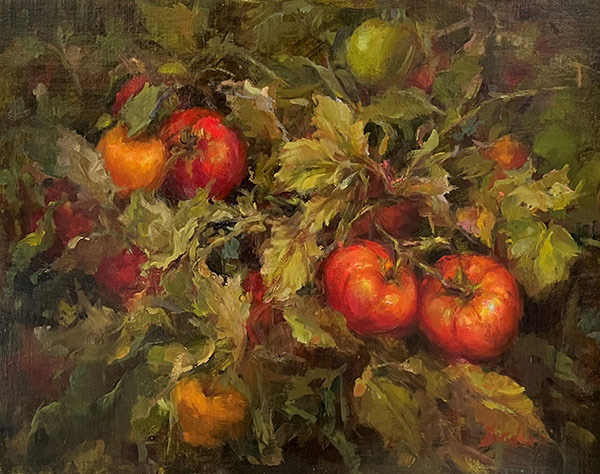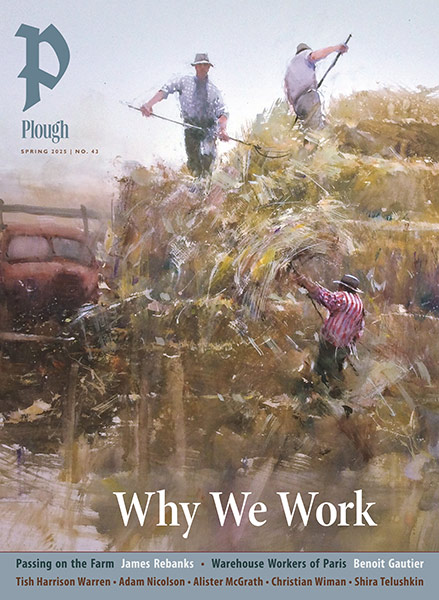Subtotal: $
Checkout
Mine is an itinerant life. Since college, I have never lived anywhere longer than four years as each stage of my husband’s medical training mandated a new location. Nor are we alone, I know, in a lifestyle that hustles us along, in which the only constant is the interstates.
I have a different dream in my soul, though. I grew up in a single house, where I could notice the trees growing from year to year. A wise friend once counseled me, even if renting, to plant fruit trees: someone will live there in ten years, whether or not you’ve moved on. I have never been brave enough to inflict an actual tree on a landlord, but otherwise I strive to live by that advice. Everywhere training took us, I poured my effort into the rootlets that anchor you to your people: playdates and coffee dates, church events, volunteering. And I have seen my efforts bear fruit, harvesting friendship in its first, second, third seasons, before moving on in the fourth.
But oh, how I envied those whose life let them stay put, to plant real trees. There’s a reason why so many moderns resonate with Wendell Berry’s ideal of “membership,” feeling a sense of both belonging and responsibility to the people of a particular place. We are hungry for a place of our own, a home and a calling specific to us. There’s something in us that longs to be tied down, rooted, constrained by something outside ourselves for which we are answerable. Yet even as the church talks endlessly about community, the financial and cultural realities of our economy keep hustling us along before we get past each other’s front porches. I longed for my own chance to nurture a plot of intermingled lives, handling each other’s eccentricities with the compassion born of shared decades.
Our last move was different. For the first time in ten years, we bought a house, in the same town as lifelong friends. We had moved to a state we loved, with stable job prospects. We got to know our neighbors, an uncommonly friendly lot for suburbia. We joined a church we hoped we could keep.
And we started to garden. It was the hobby I didn’t know I’d always wanted. Every time I added a new plant to the landscaping, I would lie awake at night imagining a new set of roots waking up and nosing about in their new surroundings, hoping they would feel at home with us. The problem is, our house is ample but our yard is not. Twelve feet wide from deck to property line, every inch shaded by fences, it was not exactly a farmer’s paradise.
I took it as a challenge. The deck gets plenty of sun for growing herbs in containers (I’m up to twenty-four pots at last count). A hedge of arbor vitae gave way to six blueberry bushes, and the overgrown camelias to espaliered pears and a fig tree flanked by flowering perennials. The shadiest end of the yard holds a few hopeful huckleberries, with a tea plant coming eventually. Our non-irrigated side yard hosts a Mediterranean medley of lavender, rosemary, and creeping thyme for culling throughout Oregon’s long soup season. And on the short side of the yard, the one patch of reliable sun holds four raised vegetable beds, with trellises for growing vertically anything that will climb. Even the corner behind the heat pump is devoted to an optimistic patch of asparagus, a perennial vegetable that takes almost as long as a tree to reach fruition.
That’s the dream, anyway. The reality is that even my “reliable” sun is patchy at best. A gardener can’t ignore the brutal specifics of location. Bright shade is not the same as full sun; a full-sun plant in bright shade will grow leggy reaching for the elusive light in which it can finally flower. Ask my perennials how I know.
Humans have their bright shade spots too. In the first two years after what we promised would be our final relocation, we made a number of good friends – only to find them moving away on the next phase of their own journey. Why had it not occurred to me that when we settled down, others would keep moving on? The growing seasons are still short, even in the promised land.
I choose to help this quirky plot be its very best self, and not to glance over the fence.
But I started to study the tomatoes. Trees get years to work their roots down deep, but vegetables naturally get only one season. Whatever my tomatoes can manage this particular year, with this combination of spring rain, heat waves, early frost – what this year gives is all they get. Their roots are not meant to endure. I rip them out to make room for winter radishes, spring peas, next year’s tomatoes.
Gardening forces me to acknowledge that rootedness is about specific conditions – not perfect ones. When God wrote the first draft of his kingdom, a set of rules for the nation of Israel, he underscored his tenth and final warning, “do not covet,” seven times: “you shall not covet your neighbor’s house. You shall not covet your neighbor’s wife, or his male or female servant, his ox or donkey, or anything that belongs to your neighbor” (Exod. 20:17). He was about to divide up a particular rocky, arid parcel of land among very specific families, who would be bound by that lottery for generations. When the psalmist said “the boundary lines have fallen for me in pleasant places,” he had a tract in mind, not of his own choosing and definitely not the same as his neighbor’s. He chooses to call it “a delightful inheritance” (Ps. 16:6). I also have a choice: to relinquish my wandering search for something better, for the sake of doing what I can with where I find myself – limitations included. I choose to help this quirky plot be its very best self, and not to glance over the fence.
Dreaming for so long about an ideal, even a good one, carries a risk that when a specific chance comes your way, you will choose instead to keep dreaming. A vision of community that only works under idealized circumstances might well undermine the actual calling of people whose lot is more likely to be the transience of the suburbs than a multigenerational family farm. Or it can inspire us, instead, to translate the same yearning into faithfulness to the post we’ve been assigned. These modern lives, too, are an inheritance, a plot uniquely given to us to till. Constraints are what give each garden its character. If your lot is a patio full of containers, you will make it more fruitful by studying up on container gardening than by pining for an orchard. Even if you still have an orchard in your soul.

Stephanie Birdsall, My Tomatoes, oil on linen panel, 2022. Used by permission.
After all those years, I got my place: a lot for growing tomatoes. It is for hosting summer hot dog roasts in the street for lack of a backyard, working out squabbles between neighbor kids whose cacophonous personalities are learning to harmonize in shared spaces. It is for miles of sidewalks, where I jog past the same hundred houses enough to recognize the unknown homeowners by the work of their hands. I might even meet them someday. To keep imagining more ideal communities would betray the responsibility I have to the actual plot I have been given to cherish, in this place, in this contemporary world. Even my years of wandering, though a tough row to hoe, were still a row – my row.
Five years in, I’ve learned a few things about tomatoes – determinate and indeterminate, heirloom, beefsteak, cherry, grape – and which ones are worth the resources of my scanty space. I’ve learned my roma tomatoes will taste about the same as the ones from the grocery store, and that if I only grow yellow heirlooms I will miss having bright red beefsteaks ripening on my counter. But the cherries are as wonderful as I remember from childhood, while tomatillos are surprisingly delightful raw. I turned my first harvest, during the worst wildfire in years, into a chutney that will forever hereafter be known in our house as wildfire jam. I learned how to hang the plants upside down in the garage before Oregon’s rainy season hits so that the last fruit can ripen without splitting from too much water, and had the satisfaction of so much ripe fruit at once that I was obligated to can salsa before it went bad. I gave up on growing all the other ingredients for salsa and made my peace with borrowing them from friends who have real farms. Sometimes I offer to make extra salsa out of their larger yields and share the jars between us. I worry less and experiment more and don’t sweat the surprises.
Outside the garden, our family found ourselves needing to change churches a couple years in. We parted ways with one homeschool group and ventured into three others. You are never done laying down rootlets, it seems. Meanwhile I’m reading up on crop rotation, how to assign my tomatoes to a different patch each year so the soil can recover its nutrients before hosting the same species twice. As it turns out, even in the rooted life, there’s a time for everything, a time to plant and a time to uproot, a time for permanence and a time for change. Cultivating this one plot well is, I am learning, more than enough for me.
Already a subscriber? Sign in
Try 3 months of unlimited access. Start your FREE TRIAL today. Cancel anytime.






